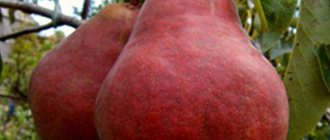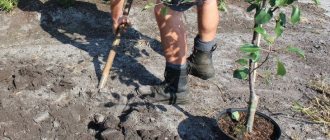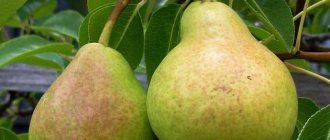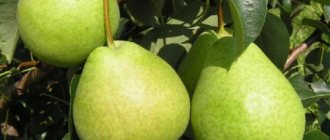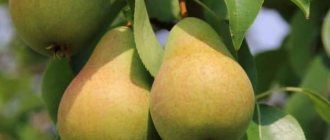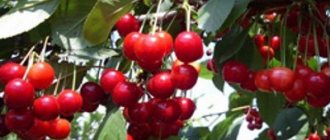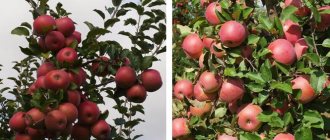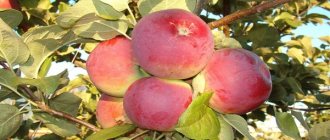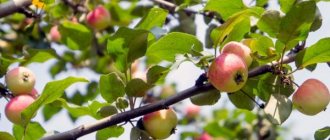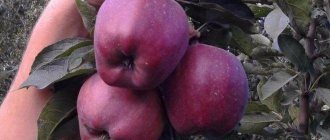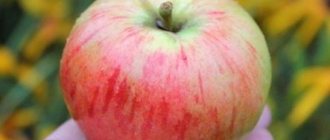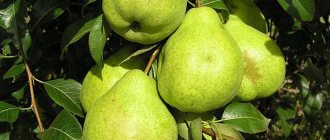Description of the Rossoshanskaya pear variety
Rossoshanskaya pear is the result of the work of domestic breeders. The varieties were bred at the Rossoshan experimental station. The institution is located in the south of the Voronezh region and is engaged in the creation of new varieties.
The first Rossoshanskaya pear variety was bred in 1952 and was named Dessert. Later, other varieties appeared - Beautiful, Early and Late. Based on the Rossoshan varieties, the hybrids Quiet Don, Severyanka, Nerussa were obtained.
According to the description of the variety and photo, the Rossoshanskaya pear is a medium or vigorous tree. The crown is pyramidal or round in shape. The pear reaches a height of 3 - 4 m. The leaves of the plant are ovoid, pointed, 5 - 10 cm long. In autumn they acquire a yellow-orange hue. The variety blooms in May. Flowers are collected in brushes of 4 - 9 pieces.
Depending on the variety, the fruits have an elongated or rounded shape. Universal use: fresh consumption, drying, making jams, compotes, juices.
Pear tree care
Tree care includes timely watering, fertilizing, removing weeds, weeding the tree trunk, frost protection and disease and pest prevention.
Irrigation mode
Trees of this variety tolerate dry weather well, but it is better not to skip watering young seedlings . Depending on the weather, it should be carried out approximately 1-2 times a week, using 1 bucket of water for each tree.
Did you know? Many varieties of pears are very whimsical, but the rowan tree is not. Therefore, pears are often grafted onto rowan trees, then their fruits grow less sweet and acquire the slight tartness characteristic of rowan berries.
If the weather is cloudy and rainy, then another watering may not be necessary. Therefore, you should always focus on the condition of the soil in the root circle of the plant. To retain moisture, the ground around the trees is mulched to a height of about 10 cm.
Fertilizer application
To increase the fertility of trees, they should be fed regularly. In this case, organic fertilizers are applied to the soil in the autumn season, and nitrogenous ones in the spring.
Find out more about the types and features of fertilizing pears.
Nitrogen is especially necessary for pears during their active growth, while organic matter is added once every 1-2 years. On average, several root feedings are carried out per season - in early autumn, late autumn before frost, early spring and during the flowering period.
Also, when the plant has flowered and active fruit growth has begun, foliar fertilizing with bromine is carried out (15 g per 1 bucket of water).
Crown formation and pruning
This variety is not prone to crown thickening, however, pruning of old, dried out and damaged branches should be carried out regularly . You should also trim shoots that grow inward towards the trunk. Young trees do not need large-scale pruning; only frozen shoots and, if necessary, tops are removed.
Varieties
There are 4 varieties of Rossoshanskaya pear, which differ in the ripening period and appearance of the fruit.
Dessert pear Rossoshanskaya
The hybrid was included in the State Register in 1965. Pears are recommended to be grown in the Central and Central Black Earth regions.
The culture has the appearance of a medium-sized tree. The variety has a rounded crown with medium density. The bark is gray, the shoots are brown. The leaves are green, large, with pointed tips. The leaf blade is smooth and curved. The flowers are white, large.
The fruits have a flattened shape and weigh about 190 g. The skin is smooth, not hard, light yellow with a crimson blush. The pulp is slightly dense, beige, and produces a lot of juice. It tastes sweet and sour, with a faint aroma. Tasting properties are rated 4.5 points. The fruits are well transported, the shelf life is from 100 to 146 days. Application - universal.
The Dessertnaya Rossoshanskaya variety has high winter hardiness. When the temperature dropped to -38 °C, freezing was 1.4-1.8 points. These are mild injuries in which some of the generative buds and annual shoots die.
The tree tolerates drought well. During the growing season it is damaged by septoria and copperhead. Scab resistance is high.
Pear Rossoshanskaya Beautiful
The Rossoshanskaya Krasivaya variety was obtained by crossing the Tonkovetka Mlievskaya variety and Lyubimitsa Klappa. In 1986 it was entered into the State Register. The variety is widespread in the southern regions of the Black Earth Region, the North Caucasus and the Volga region.
The trees are vigorous and have a pyramidal crown. The crown is sparse, the bark is dark gray, the skeletal branches are brownish. The shoots are long and straight. The leaves are green, shiny, medium sized. The buds are pink and white.
The fruits of the Rossoshanskaya Krasavitsa pear are medium in size and weigh 120 g. The shape is pear-shaped and elongated. The skin is smooth, non-rigid, white-yellow, covered with green dots. The color is blurry, red. The inside of the pear is yellowish, juicy, sweet with a sour aftertaste. The variety was given a tasting score of 4 points. The fruits hang on the branches for a long time before ripening. The pear is well stored and transported.
The winter hardiness of the variety is high. At a temperature of -34 °C, the degree of freezing of shoots is up to 1.3 points. Drought resistance is average. If there is a lack of moisture, the fruits become smaller. The inflorescences do not tolerate spring frosts.
Important! When the temperature drops to -2 °C, the flowers of the Rossoshanskaya variety fall off.
Scab resistance is average. In the conditions of the Voronezh region, a tree rarely gets sick. More often, signs of the disease appear when planting in the Oryol region.
Pear Rossoshanskaya Late
It is considered one of the best among winter varieties. The fruits are enlarged, weighing 250 - 350 g. The shape is round, the color is yellow-green. When ripe, the skin turns yellow. When exposed to the sun, a red blush appears.
According to the description, the Rossoshanskaya Late pear has a good taste and presentation. The pulp is beige, tender, with a pronounced aroma. The harvest is harvested in mid to late September. Storage period - until February. If you remove the fruit later, the pulp picks up more sugar. This reduces the storage time of the pear.
The tree is medium-sized, has a rounded crown. Winter hardiness is high; at a temperature of -32 °C, freezing is estimated at 1.5 points.
Pear Rossoshanskaya Early
The variety was obtained by cross-pollination of Mramornaya and Rossoshanskaya Krasivaya pear seedlings. Varietal testing has been taking place since 1995. Tree of medium to high vigor. The crown is not thickened. The bark on the trunk is dark gray.
The shoots are brown in color and branch weakly. The leaves are ovoid, green, shiny, curved along the vein. Umbrella-shaped inflorescences with white flowers.
The fruits are elongated and medium in size. The skin is smooth, golden yellow. Most of the pear has a red-orange blush. The surface is covered with small subcutaneous dots. The taste is sweet and sour, rated 4.7 points. The pulp is yellowish, tender, oily.
The Rossoshanskaya summer pear tolerates temperature drops in winter down to -30 °C. Cold snaps in the fall are more dangerous for the tree. The variety also does not tolerate spring frosts.
Characteristics of the variety
The variety was obtained in 1952 at the Rossoshan experimental station near Voronezh. The parent varieties of the new variety were Bere winter Michurina and Forest Beauty. After another 16 years, all state tests were successfully completed and the variety was transferred for use in the national economy. The main growing areas for Rossoshan steel are the North Caucasus, Central regions and Southern Black Earth Region.
The Rossoshanskaya dessert pear variety is interesting not only for the attractive appearance of the fruit, but also for its wonderful taste, which will satisfy the demands of even the most demanding gourmets
Botanical description of Rossoshanskaya:
- tree - medium and vigorous, up to a maximum of 15 m;
- crown - pyramidal, not thickened, wide;
- bark - dark brown with a grayish tint;
- branches - strong, straight, light brown;
- leaves - green, medium, oval, smooth;
- flowers - self-sterile, white, double, pink edging;
- fruits are yellow-green with rusty dots, often with a pink blush, apple-shaped, weight 140–170 g (up to 200 g);
- pulp - homogeneous, juicy, sweet, aromatic;
- peel - thin, dense;
- Fruiting - 5-6 years from planting;
- yield - up to 70 kg per tree, 120–300 centners per 1 ha;
- frost resistance - good;
- the purpose of the variety is universal;
- Ripening time is early September.
Rossoshanskaya is especially widespread in industrial gardening. This was facilitated by its resistance to cold, stable excellent yield and resistance to typical pear diseases - scab and septoria.
Important! The leaves on pear shoots grow strictly at an angle of 135°, which allows them to receive the maximum amount of sunlight and heat.
Resistance to diseases and pests
Trees of the Rossoshanskaya pear variety are resistant to diseases that affect garden crops, as well as insect pests. The seedlings show high immunity to scab and septoria.
Drought resistance, frost resistance
Frost resistance is high. The varieties can withstand temperatures down to -34 °C with a slight degree of freezing (1.3 points).
The drought resistance indicator of Rossoshanskaya pear varieties is determined as average. The tree can withstand the absence of moisture for a short time without consequences. A longer dry period will lead to smaller fruits and deterioration in presentation.
Pros and cons of the variety
Rossoshanskaya pear is characterized by the following advantages:
- early onset of fruiting;
- high yields of dessert pears;
- excellent taste;
- excellent presentation of the fruit;
- frost resistance and unpretentiousness to soil and care;
- good transportability and long-term storage;
- resistance to pests and diseases of fruit trees;
- high sugar content.
The only disadvantages of the variety include the need for pollinators and regular pruning to thin out the crown. In addition, in the northern regions there is a decrease in the level of frost resistance.
Planting and caring for Rossoshanskaya pear
In order to regularly get a high yield, it is important to plant the pear tree correctly and provide it with care. During the season, the crop requires watering and fertilizing, and in the fall - preparation for winter.
Landing rules
Pears are planted in late autumn, after leaf fall has ended. 2 - 3 weeks before the cold weather, the tree has time to take root. Seedlings are purchased from nurseries or other trusted suppliers. The plant is assessed visually for the absence of cracks, mold and other defects. If the cold snap comes earlier, the seedlings are buried in the ground and covered with sawdust until spring.
A planting hole is prepared for the pear. It is left for 3 weeks to allow the soil to shrink. If this is not done, the seedling will be damaged. For spring planting, the pit is prepared in the fall.
Planting procedure for Rossoshanskaya pear:
- First, dig a hole 60 cm in size and 50 cm deep.
- Mix 30 kg of compost, 400 g of superphosphate and 180 g of potassium salt into fertile soil.
- Half of the substrate is poured into the hole and compacted.
- A small hill is formed from the remaining soil, and a seedling is placed on it.
- The roots of the plant are covered with earth.
- The soil is well compacted and watered.
After planting, the pear tree is watered every week. The soil is mulched with humus. In the next 2 - 3 years, the crop does not require fertilizing.
Watering and fertilizing
It is enough to water the Rossoshanskaya pear before and after flowering. The tree needs moisture to form ovaries. 3-4 buckets of warm water are poured into the tree trunk circle. Additional watering is possible in dry weather. Moisture should not stagnate in the soil. After watering, loosen the soil and mulch with peat. In the fall, the last pre-winter watering is performed.
During the season, the crop is fed 3-4 times. In early spring, nitrogen fertilizers are applied: a solution of urea or mullein. Fertilizing stimulates the growth of green mass. After flowering, the tree is fed with a solution of Nitroammophoska.
Advice! When the fruits ripen, pears switch to formulations with potassium and phosphorus.
Add 40 g of superphosphate and potassium salt to 10 liters of water. The solution is poured under the root or embedded in the soil before watering. Feeding is repeated in mid-September so that the tree gains strength after fruiting. Instead of minerals, use bone meal or wood ash.
Trimming
The pear is pruned in early spring, before sap flow begins. A pyramid-shaped crown is formed for the tree. The first treatment is carried out immediately after planting. The central conductor is shortened by ¼. Skeletal shoots are identified, the remaining shoots are cut off. Broken, frozen and diseased branches are removed annually. It is allowed to prune in the fall, when the leaf fall ends.
Whitewash
Whitewashing is carried out in November or early March. The procedure protects the tree bark from temperature changes and spring burns. During the whitewashing process, the larvae of pests that overwinter on trees are destroyed.
You can use a ready-made composition or make it yourself from water, lime and clay. In a pear, the lower part of the trunk is processed from the skeletal shoots to the ground. Whitewashing is necessary for adult and young trees. For seedlings, a less concentrated mixture is obtained.
Preparing for winter
Preparing pears for winter begins in late autumn. The tree is watered so that the moist soil protects it from the cold. Then the trunk is covered with earth and a layer of humus mulch is poured.
Advice! To prevent mice from gnawing on the pear in winter, the trunk is wrapped in mesh or a metal pipe.
Young plantings need additional protection from the cold. A wooden frame is built over the pear and agrofibre is attached. The top of the planting is covered with spruce branches. Polyethylene, which does not allow moisture and air to pass through, is not suitable for shelter.
Landing rules
Like any cultivar, the Rossoshanskaya pear has its own characteristics and nuances of agricultural technology. Planting is an important stage in the life of a tree. Its further growth and development depends on how correctly the seedling is placed in the ground. The planting algorithm also includes preparatory measures - choosing a time, a site, preparing the soil. Each stage requires careful adherence to the rules.
Recommended timing
Late autumn (after the end of leaf fall) is ideal for planting Rossoshanskaya pear seedlings in the southern region. The seedling only needs 3 weeks before the onset of cold weather to take root. The best time is before October 15th. For areas with a cool climate, spring planting is preferable - at the end of April.
Site selection and soil preparation
For good tree development, you need to select a sunny area without gusts of wind and drafts.
Soil requirements:
- allows moisture and air to pass through well;
- loose and nutritious;
- the groundwater level is no closer than 3 m to the surface;
- acidity level – neutral or slightly acidic.
If there is no place on the site that meets the listed parameters, the soil is further structured and prepared for planting. In the fall, the soil is dug up and organic matter is added (30 kg per 1 sq. m of area).
Selection and preparation of seedlings
It is recommended to purchase Rossoshanskaya pear seedlings from trusted suppliers or certified nurseries. It doesn’t matter what kind of root system they have, closed or open. Age: two years old. Parameters to pay attention to:
- No mechanical damage to the trunk bark or branches.
- The seedling should have 7-8 developed shoots.
- The length of the main root is 10-15 cm, the roots are clean, without signs of rotting or deterioration.
If the root system is open, measures should be taken to ensure comfortable transportation of the seedling.
Landing algorithm
In the area selected for planting, perform the following actions:
- A pit is formed with a diameter of 60 cm and a depth of 50 cm.
- Prepare soil from 30 kg of compost, 180 g of potassium salt and 400 g of superphosphate.
- Fill the pear hole halfway with the substrate and tamp it lightly.
- A mound is formed from the remaining soil in the middle of the pit.
- Place a seedling on it and straighten the roots.
- Cover with soil, compact, and water generously.
- Mulching. To do this, lay a layer of humus around the entire circle around the trunk.
Now all that remains is to comply with the care requirements.
Pollination
To form ovaries, pears require pollinators. For planting, select varieties that bloom at the same time. Other factors influence the pollination process: warm weather, lack of rain, cold and heat. The pear is planted on a plot with an interval of 3 - 4 m. If it is not possible to place several trees, then choose a resistant rootstock. Different varieties are grafted into the crown.
The best pollinators for Rossoshanskaya pear:
- Marble. The variety is widespread in the Central and Central Black Earth regions. Medium-sized tree with a wide pyramidal crown. Fruits weighing 160 g, regularly conical in shape. The skin is dense, green-yellow with a reddish marbled blush. The variety is valued for winter hardiness and fruit quality. The main disadvantage is sensitivity to lack of moisture.
- Tatiana. An autumn variety, it is a tall tree with a sparse crown. Fruits weighing up to 230 g. The pulp is creamy and sweet. The color is yellow-golden with a blurred blush. The variety has dessert qualities and winter hardiness. Weakly affected by scab and powdery mildew.
- Autumn Yakovleva. An autumn fruiting variety, found in the middle zone. The tree grows quickly and forms a rounded drooping crown. The fruits are medium in size, greenish-yellow in color with a blurred blush. The pulp is homogeneous, tender, oily. Needs treatment for scab.
Early pear
Early Rossoshanskaya pear is represented by vigorous specimens with a large, wide-pyramidal crown. The basic branches forming the skeleton are fused to the trunk almost at a right angle. The bark of skeletal shoots is gray, in young shoots it is reddish-brown, speckled with small lentils. The tree branches weakly, the shoots are directed upward. Early is characterized by a mixed type of fruiting, including annual growth.
The crown of medium density is formed by glossy ovoid leaves with a serrated edge. The color of the plates is green, there is a bend along the midrib.
Umbrella-shaped inflorescences appear in the middle period. The corollas of the flowers are white, cup-shaped with oval petals. The bud is medium in size and has a light aroma.
Early Rossoshanskaya, the description of which we are considering, has flowers that are unstable to spring frosts. Under unfavorable conditions they will require additional protection.
Fruit
The fruits on “Rannya” are medium-sized, weighing up to 180 g. The shape is elongated pear-shaped, with pronounced symmetry and a smooth surface. The color of the glossy skin is golden yellow with a subtle reddish-orange tan on most of the pear. Under the skin there are brown freckles, located very close to each other. Because of the dots, the surface of the fruit appears uniformly rusty.
A cut reveals a creamy yellow flesh with an oily texture. Sourish-sweet taste, abundance of juice, moderate aroma - these are the taste characteristics of the fruits of Rossoshanskaya Early. Tasters gave them a score of 4.7 points, and 4.6 points for their attractive appearance.
Pears ripen towards the end of summer and are stored for about 1 month. Transportability is rated as average. Universal use - fresh consumption, preparation of preserves - compotes, juice, jam.
Early fruits are not prone to shedding. The cultivar is valued for its excellent taste and pleasant appearance, which you can appreciate in the photo.
Advantages and disadvantages
Let's consider the advantages of this variety:
- high productivity - up to 130 centners per hectare;
- early maturity (early harvest);
- when cultivated in adapted regions, frost resistance is average;
- exceptional immunity to scab;
- high marketability and transportability, excellent taste characteristics;
- stability of fruiting.
Among the disadvantages, gardeners noted the low cold resistance of flowers and late entry into fruiting. The first harvest from the tree is harvested 8 years after grafting onto the rootstock in a nursery.
Ripening period of Rossoshanskaya pear
The period of fruit ripening depends on the variety. In the second half of August, the Rossoshanskaya Early pear is harvested. The variety is a summer variety; the fruits are stored for 30 days. The ripening period for the Rossoshanskaya Krasivaya pear in the Black Earth Region is mid-August. The fruits are suitable for consumption within a month.
The Desertnaya variety produces a harvest in early September. The fruits are stored for no more than 80 days. Late Rossoshanskaya pear bears fruit in mid-late September. In cool conditions, the fruits are kept until January.
Reviews
Kirill Isaev, Voronezh region: The Dessert pear Rossoshanskaya bears fruit every year, the growth of shoots is not too abundant, it grows slowly. The leaves are slightly affected by scab, although the State Register description indicates resistance to this disease. The fruits remain uninfected. The taste is sweet.
Marina Pashkova, Voronezh: Dessert Rossoshanskaya is easy to care for. Fruits every year. The fruits are sweet, but if they become overripe, they lose their juiciness.
Svetlana Egorova, Rostov region: The fruits of Dessertnaya Rossoshanskaya are juicy and very sweet. Their size ranges from 150 to 250 g. Beautiful appearance. They ripen in early September and are quietly stored in the basement for several months.
Diseases and pests
The most dangerous disease for the Rossoshanskaya pear is scab. The lesion looks like dark spots that appear on leaves, fruits and flowers. Gradually, the spots increase to 2 - 3 cm. As a result, the fruits become small and hard, their taste and presentation are lost. To combat scab, the drugs Skor, Strobi, Horus are used. Treatments are carried out every 2 weeks.
Important! To prevent diseases, fallen leaves are removed annually and shoots are pruned.
The pear attracts copperhead, leaf roller, codling moth, aphids and other pests. Insects feed on tree sap, which slows down its growth and reduces yield. To get rid of pests, insecticides Agravertin, Iskra, Decis are used. Trees are sprayed with working solutions leaf by leaf. A good preventative measure is digging up the soil in the tree trunk circle and whitewashing the trunk.
Care and planting
Dessert pear Rossoshanskaya prefers loosened soil. It is filled with oxygen and stimulates the growth of seedlings. A little clay won't hurt to maintain moisture at the very base of the roots.
The future landing site should be well lit by the sun. It is best to choose a place on a hill on the southwest side. The root system likes dampness, but too much moisture can cause the tree to wither.
You can plant a tree in late spring, but it is better in early autumn. It is necessary to prepare holes for planting in advance.
Planting stages
- The layer of soil removed from the hole must be mixed with fertilizers (peat, compost, manure). Pour the resulting mixture into the hole to the brim.
- Pour soil into the bottom of the hole and drive a peg in the middle. Place the seedling in the hole and straighten the roots. Fill the top with soil and tamp lightly.
- After planting, water the plant generously with two buckets of water and mulch the soil around it. Tie the tree to a stake.
Rossoshanskaya pear needs warmth and protection from the wind. Otherwise, the pear will not produce good fruit.
Also, do not neglect circumcision. It is necessary to trim the crown or roots of the tree. Additionally, growth hormones can be used to regulate the corresponding process.
Trimming
In the first year of life, the tree is not pruned, but in the second year the crown begins to form. The crown is formed within three years.
Every year they make one tier, which consists of several skeletal branches. Between the tiers you need to make a distance of about 50 cm. An old tree needs to remove dried branches, as well as branches that have sank too far to the ground.
Watering
Despite the fact that Dessertnaya Rossoshanskaya is drought-resistant, it requires abundant watering. It is recommended to perform 3-4 waterings per season. The amount of water depends on the climate and weather in the area where the tree grows.
Two buckets of water will be enough for a young plant. An older tree needs two buckets of water for every year of its life.
Dessert pear Rossoshanskaya prefers loosened soil and abundant watering
Fertilizer application
In its second life, you can start feeding the tree. Fertilizers are applied in autumn and spring, and fertilizing is done in summer.
Mineral fertilizers are applied annually, and organic fertilizers are applied every few years. Fertilizers must be applied to a pre-dug ditch around the tree. The length of the ditch depends on the amount of fertilizer. First, mineral fertilizers and then organic fertilizers are poured into the ditch, mixed with soil.
Reviews of Rossoshanskaya pear
Kuznetsov Vasily Petrovich, 48 years old, Voronezh
The Rossoshanskaya Dessert pear has been growing on my plot for more than 8 years. I grafted the variety onto a wildflower seedling. During this time, the height of the tree did not exceed 2.5 m. The yield was high and stable. 3 - 4 pears are tied in a brush. Sometimes scab appears on the leaves, but the fruits do not suffer from disease. If you process it regularly, there will be no problems with this. The winter hardiness of the tree is high; the wood is not damaged after cold weather. The taste of the fruit is excellent and is perfect for processing.
Ermolina Maria Alexandrovna, 54 years old, Belgorod
I recommend Rossoshanskaya Krasivaya pear to lovers of sweet varieties. The pulp is juicy and oily. The taste is sweetish with pleasant sourness. The tree is unpretentious and stable. The harvest ripens in mid and late August. The variety is partially self-fertile, so its yield is always high. The fruits are reddish, have a good presentation and weigh about 150 g. I constantly spray the garden against diseases, so the tree always looks healthy.
Description of fruits
Dessertnaya Rossoshanskaya pears are leveled, medium size. Most specimens reach 150-160 g. In some cases, you can find fruits weighing 200 g or more. The shape is more reminiscent of an apple than a traditional pear. The fruits are round, slightly flattened on top and bottom.
The skin is smooth, and during the period of removable maturity it has a green-yellow color with a slight blurry blush. Subsequently, the skin becomes light yellow in color. Brown and dark gray distinct subcutaneous dots are observed.
The flesh is cream or white. Tender, juicy and sweet, without grains, with barely noticeable sourness and a delicate aroma. According to professional tasters, the fruits of Dessertnaya Rossoshanskaya are rated from 4.5 to 5 points on a five-point scale. The sugar content is 10.2%, titratable acids – 0.08%, dry substances – 14.8%.
The taste declared by the originator appears several weeks later, and not immediately after picking from the tree.
Pears have excellent presentation and good transportability. Therefore, in the late 1970s - early 1990s, this variety was often used in industrial gardens. However, the consumption period is not too long - the fruits are stored until approximately November. It is best to store them in a refrigerator or warehouse at t = 0 C.
The level of vitamin C is quite high (10 mg/100 g), so the variety is recommended for fresh consumption. It is also used for making compotes, jams, preserves and candied fruits.
